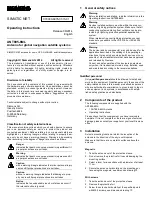
4) The
trunion assembly
is stored in a corner of the lower half of the case and provides two axis
(azimuth and elevation) freedom for the dish. The trunion mounts directly on to the trunion support
tube which is an integral part of the case. The pivotal bolt on the back side of the reflector dish
rests in the vertical slot in the trunion forks. The trunion assembly is shown in Figure 3. The
trunion actually consists of upper and lower halves, drawn together by a single, large bolt. This bolt
is tightened prior to shipment and it is not intended that it be utilized for antenna operations.
Should it become loose it can be re tightened with a 15/16" wrench.
5) The
elevation adjustment mechanism
provides both coarse and fine elevation adjustment.
Coarse adjustment comes from the telescopic action of the inner and outer cylinders, locked in
place with the large black knob. Fine adjustment is possible by turning the entire assembly when it
is installed between the antenna support arm and the elevation support bracket (on the trunion
assembly). The elevation adjustment assembly is shown in Figure 4.
6) The
radio arm
provides the primary central support and proper alignment (less polarization) of
the radio with respect to the reflector. A slot in the end of the radio arm engages a bolt in the lower
end of the dish support arm while a hole in the radio arm engages the dish with an alignment pin.
The radio arm is held upright by the side arms. The radio arm is depicted in Figure 5.
7) Two
radio side arms
, shown in Figure 6, provide the side connections between the dish and
the radio arm. The two arms are slotted at each end and are interchangeable from left to right.
8)
Inclinometer
. A magnetic Polycast Protractor is included with the antenna. This large dial
readout device will assist with elevation adjustments. After determining the required look
angle, use this device to set the elevation angle of the antenna. This protractor has a
magnetic base and can be attached to the angled box-beam segment of the antenna support
arm (on the back side of the lower dish segment). It should be noted that this protractor, when
magnetically attached to the lower segment of the dish support arm will read the complement
of the antenna look angle (90 minus look angle). For instance, if you desire a 37 degree look
angle (37 degrees from local horizontal) then you would tilt the reflector dish in elevation until
the protractor reads 90 - 37 = 53 degrees. Figure 11 will show where the magnetic
inclinometer attaches to the dish support arm.
9)
Compass
(and inclinometer). A Silva Ranger compass, model 15CL, is also included in
the antenna package. This compass will help to point the antenna in the proper azimuth
direction. This device can also be used as an inclinometer instead of, or in addition to, the
Polycast Protractor. It can be adjusted to indicate the actual look angle (as opposed to the
complement). It has a smaller dial than the Polycast Protractor, however. Refer to the Silva
instruction manual for operational details and features, including the procedure for inserting
magnetic declination.
7









































